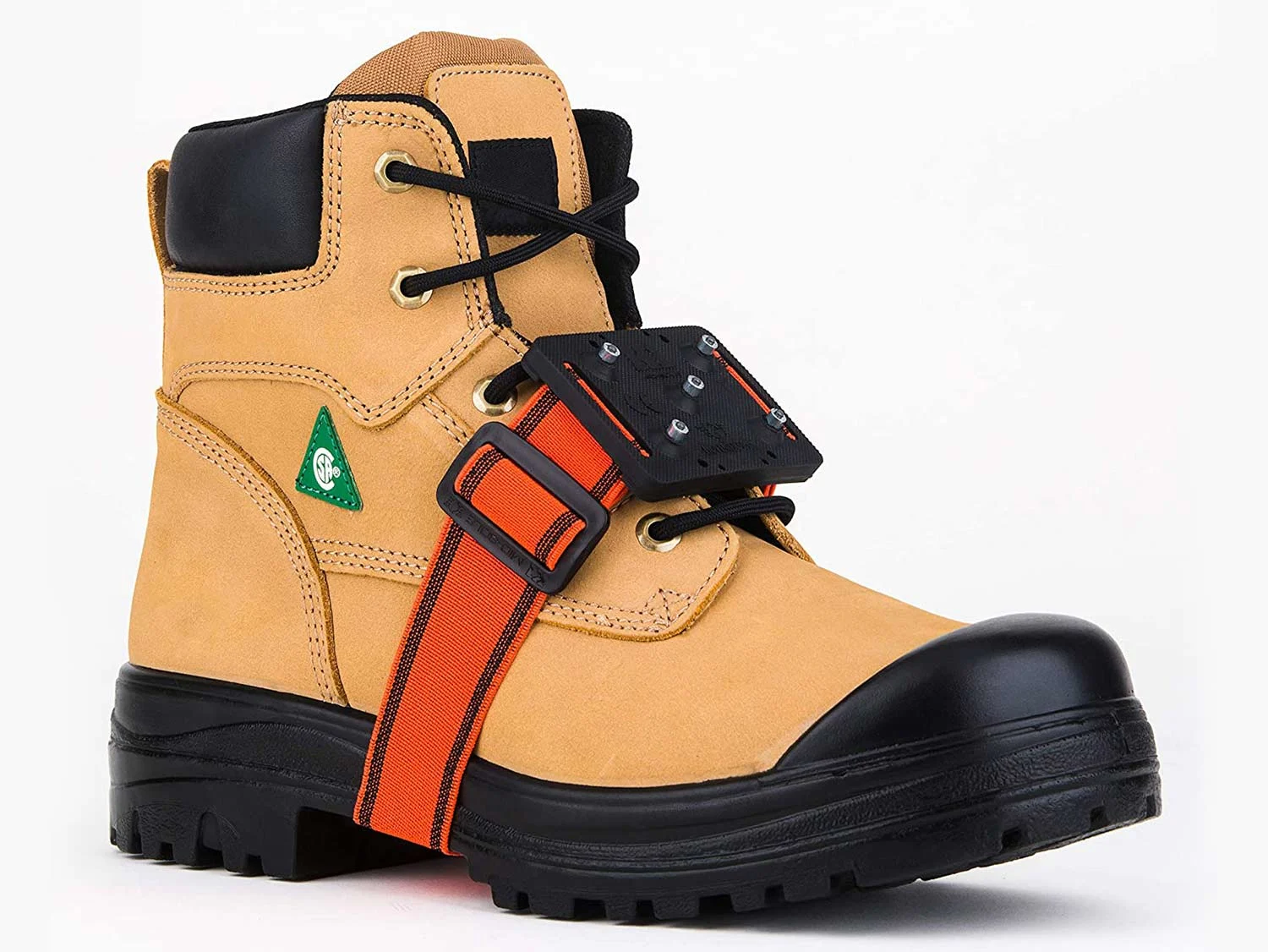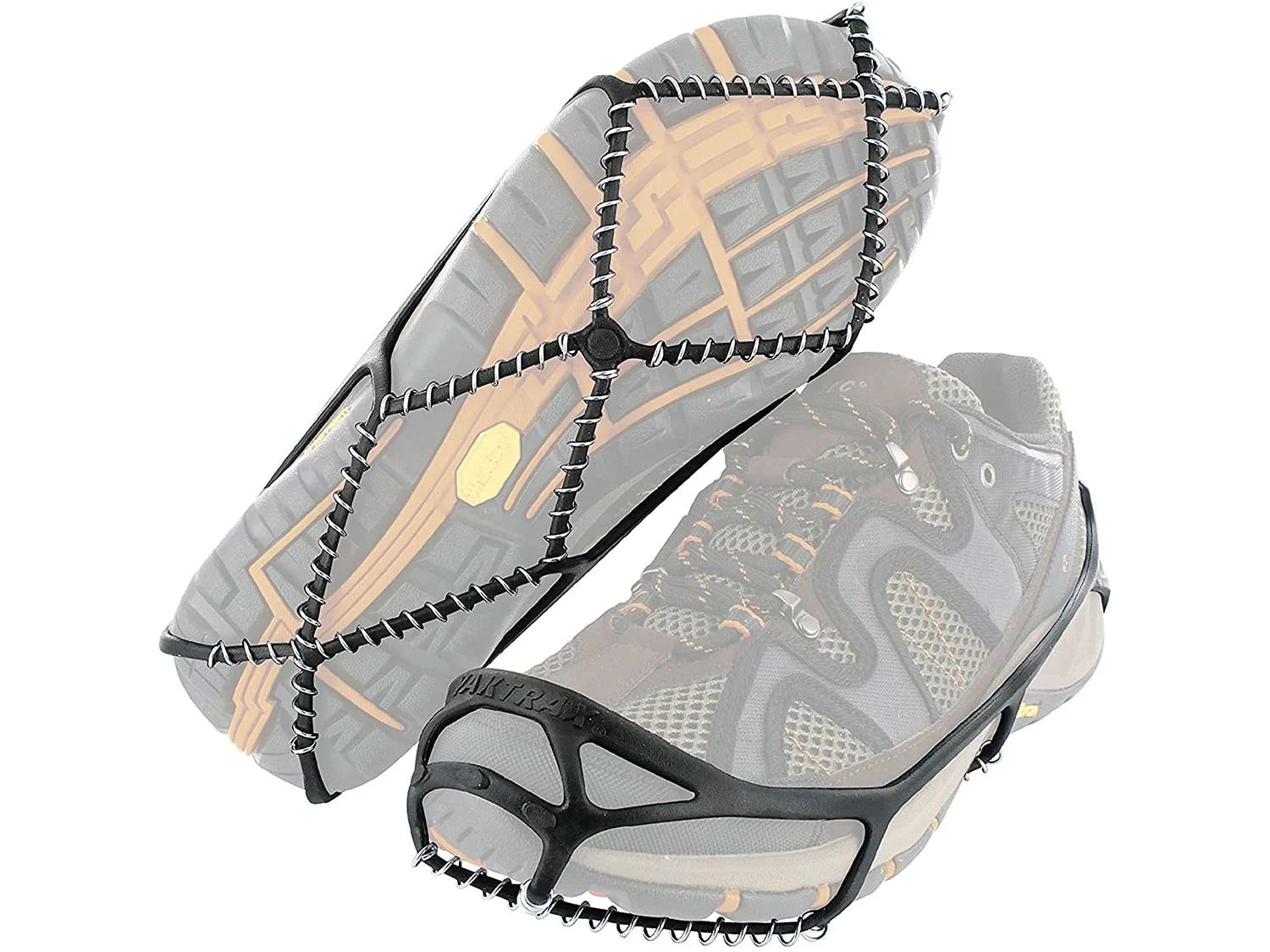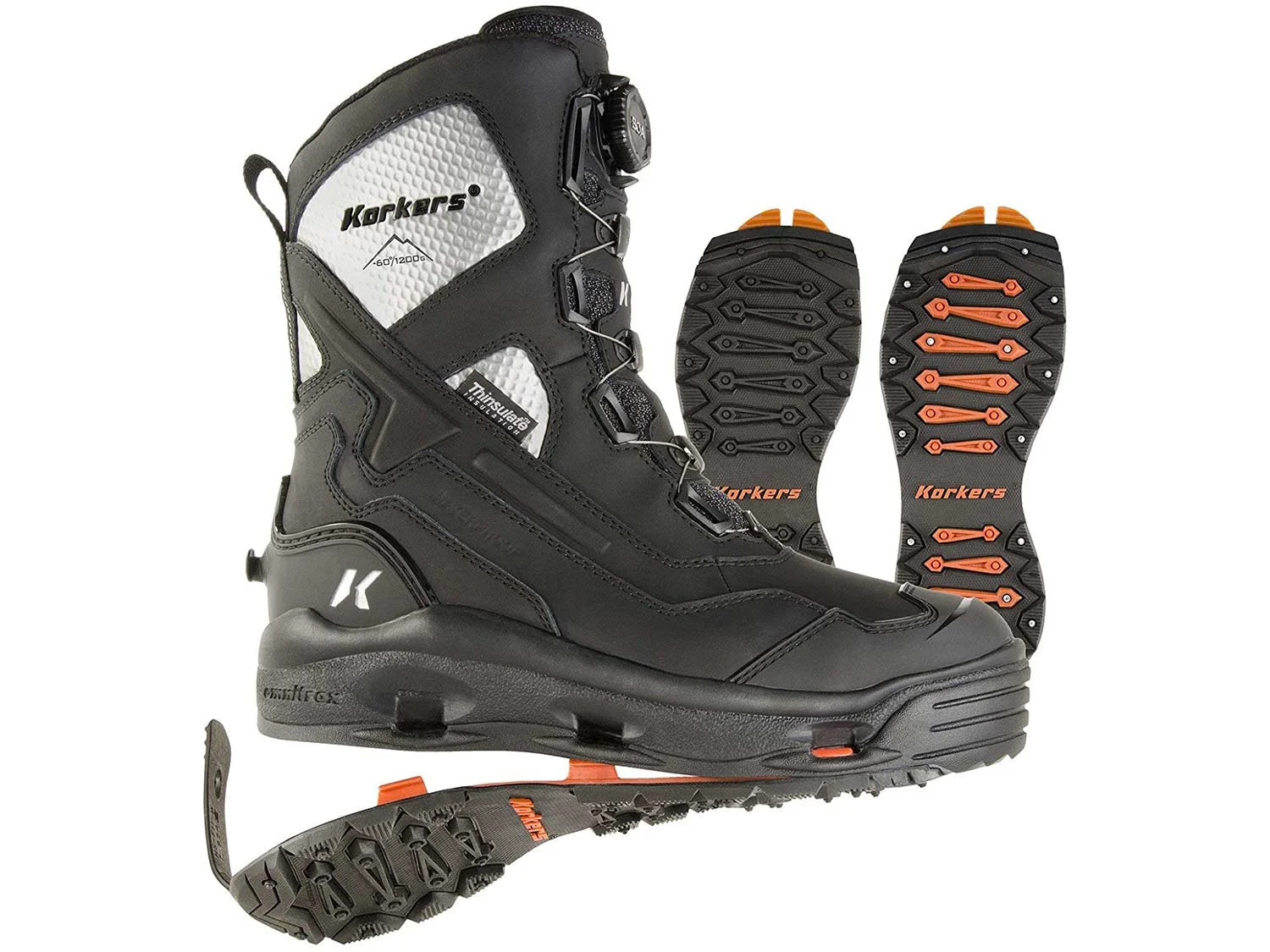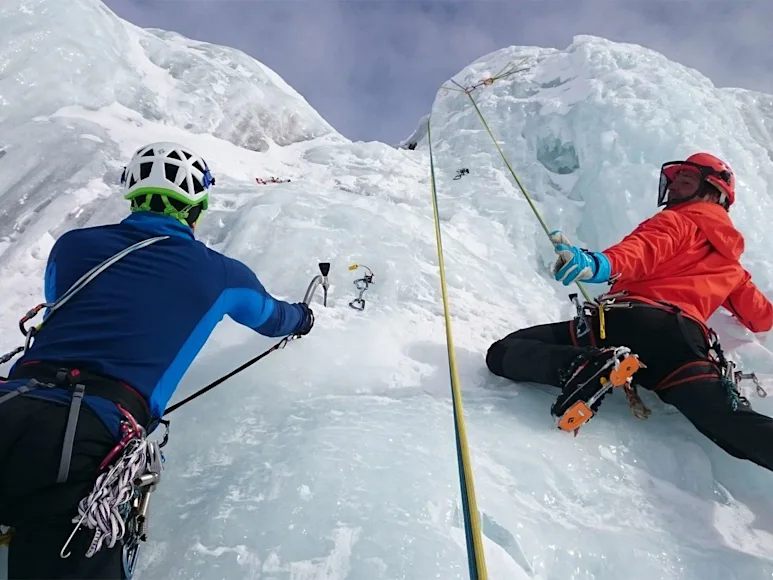_We may earn revenue from the products available on this page and participate in affiliate programs. Learn more ›
_
Best for Ice Fishing and Hiking

Unigear Traction Cleats
LEARN MORE
Summary
Unigear Traction Cleats provide sure traction on solid ice and frozen trails.
Best Rotating

K1 Mid-Sole Ice Cleats
LEARN MORE
Summary
You can leave the K1 Mid-Sole Ice Cleats on your boots all winter long.
Best Budget

Yaktrax Walk Traction Cleats
LEARN MORE
Summary
Yaktrax Walk Traction Cleats perform well in most winter conditions.
Ice cleats have prevented millions of slips and falls over the years. And considering how little they cost, they’re a worthwhile investment in your safety and confidence.
What is an ice cleat? It’s a simple device that you affix to the bottoms of your shoes or boots for extra traction, which is usually provided through some form of metal cleating. Ice cleats for shoes or boots can prove to be life-savers in winter conditions by helping you avoid dangerous falls, whether you’re shoveling the driveway or walking home late at night. Ice fishermen use ice cleats all the time.
Ice cleats are little siblings to crampons. Crampons are heavy-duty traction devices that were designed primarily for ice climbing and mountaineering. In comparison, ice cleats are typically lighter weight and don’t feature front-facing spikes designed for jamming into steep ice walls. The best ice cleats are lighter, less bulky, and more affordable than a pair of crampons. Crampons
are as useful for the avid outdoorsmen as they are for the average joe. Affix them to your boots or shoes when you’re going ice fishing, hiking in the winter, or simply walking your dog.
Best Overall: Unigear Traction Cleats
Best Rotating: K1 Mid-Sole Ice Cleats
Best Crampons: Black Diamond Contact Crampon
Best Studded Snow Boot: Korkers Men’s Polar Vortex 1200 Winter Boots with Interchangeable Sole
Best Budget: Yaktrax Walk Traction Cleats
Best Ice Cleats: Reviews and Recommendations
Best Overall: Unigear Traction Cleats

Unigear Traction Cleats provide sure traction on solid ice and frozen trails. Unigear
Unigear’s Traction Cleats offer everything you should look for in a pair of heavy-duty ice cleats for boots. The best part? They’re not actually very heavy. Each cleat weighs only around 8 ounces. The full-sole coverage includes 18 spikes per foot, with 12 spikes at the forefoot and 6 spikes at the heel. The ½-inch long spikes are made out of high-quality stainless steel. Strong chain links make the cleats durable and powerful. Stretchy Thermoplastic Elastomer secure the cleats to your boots firmly while offering anti-abrasion qualities. Added over-foot straps keep these cleats extra secure.
Best Rotating: K1 Mid-Sole Ice Cleats

You can leave the K1 Mid-Sole Ice Cleats on your boots all winter long. K1
The K1 Mid-Sole Ice Cleats are one of the most popular ice cleats on the market for good reason. Ice-penetrating tungsten carbide studs provide excellent grip. The cleats are sturdy but not bulky. A one-size-fits-all strap secures the studs firmly to the bottom of your foot. You can easily rotate the strap so that the cleat sits on the top of your shoes or boots when you don’t need them. The strap is also made in a Hi-Vis orange that adds an additional level of safety in low-light and low-visibility situations.
Best Crampons: Black Diamond Contact Crampon

The Black Diamond Contact Crampon is a trusted piece of winter mountaineering equipment. Black Diamond
Black Diamond is a well-regarded climbing company that offers its products at reasonable prices. The company’s Contact Crampon is a solid choice for exploring the high-alpine during snowy and icy conditions. The stainless steel construction doesn’t rust and is durable and reliable. It resists snow-bailing and is lightweight. The low-profile construction fits modern boots well, and the flexible toe-strap is compatible with most footwear. Wear these crampons with confidence.
Best Studded: Korkers Men’s Polar Vortex 1200 Winter Boots with Interchangeable Sole

The Korkers Men’s Polar Vortex 1200 Winter Boots have built-in ice cleats, and the studded soles are interchangeable with non-studded soles. Korkers
The Korkers Men’s Polar Vortex 1200 Winter Boots are designed for extreme conditions, and have interchangeable soles. The IceTrac Studded Rubber Lug Soles feature 32 carbide studs per pair, making them ideal for icy and snowy conditions. The studded soles can be replaced with SnowTrac Winter Rubber Lug soles, which are better for wet and dry conditions when studs aren’t needed. The boots have 1200g of 3M Thinsulate insulation, which provides a heavy dose of warmth for near-arctic conditions. A single Boa fit system that’s usually found in snowboard boots allows you to tighten and loosen the boots easily, even when your hands are numb.
Best Budget: Yaktrax Walk Traction Cleats

Yaktrax Walk Traction Cleats perform well in most winter conditions. Yaktrax
Yaktrax is one of the most popular brands of ice cleats, and for good reason. The company puts out a line of well-made cleats at affordable price points, and their Yaktrax Walk Traction Cleats are lightweight, affordable, and effective. Spiraled 1.2 mm steel coils with zinc coating to prevent rust provide 360 degrees of traction. Because the ice cleats don’t utilize spikes, they’re not great in extremely icy conditions but are versatile and stable on level and near-level terrain. With an elastic outer band, these cleats are easy to slip on and off.
Features To Consider When Shopping For The Best Ice Cleats
To find the best ice cleats for your winter adventures, you need to consider several things. First, how much are you willing to spend? Ice cleats range from under $10 to well over $100. Also, there are many options out there with different specific applications, from the everyday type of ice cleat to the much more aggressive crampons.
Note that you won’t want to wear your ice cleats indoors. They’ll damage wood flooring and carpets. Aside from that, if your cleats use metal to generate traction, they can become slippery on surfaces that they aren’t able to dig into.
Will You Be Ice Fishing or Hiking?
If you are the kind of person who doesn’t let snow and ice keep you away from the outdoors, you need a pair of ice cleats that are as tough as you are. This means you should look for ice cleats that are a grade higher than the typical cleats you will find on the market today.
If you’re going ice fishing
on wind-stripped lakes or hiking on steep icy trails, you need a pair of ice cleats that has more than a coiled or lightly studded bottom. Look for ice cleats that toe the line between climbing crampons (see below) and lightweight ice cleats. A rugged pair of ice cleats will have metal traction devices that are usually connected with chain links. They should be strong and sturdy, but light enough not to slow you down.
Will You Need to Put on and Take off the Ice Cleats Often?
Ice cleats are typically made to be worn only when you’re outside in icy conditions. You’ll need to remove your cleats when entering a bar or hardware store and then put them on again when you’re leaving, and take them off again if you’re going to be driving more than a short distance. That can slow you down, cause you to not bother putting them on, and setting yourself up for a dangerous fall.
In that case, you should consider mid-sole ice cleats. Basically, they provide traction only on the part of the soles of your boots or shoes that don’t usually make contact with the ground. Models that allow you to spin the cleats around before you go inside, instead of having to take them off altogether, are ideal for such situations. The downside is that the traction is concentrated in one part of your foot and doesn’t extend across the entirety of your soles, like most ice cleats do.
Will You Be Climbing or Mountaineering?
A crampon is like the big brother to the ice cleat, and the two terms are often confused on retailer websites. Don’t be fooled. A traditional crampon is a heavy-duty piece of winter gear that is designed for extreme outdoor expeditions, from ice climbing to ski mountaineering. A true crampon has a platform bottom with sharp metal spikes that jut out at the bottom and at the front, so you can navigate steep or uneven areas. Crampons are a must have if you’re tackling extreme winter expeditions, but they’re usually unnecessary for the average outdoorsman.
When you’re looking for crampons, always consider reliability. Odds are you will use your crampons to ascend steep, icy slopes where equipment failure could prove disastrous. Don’t skimp on your crampons. Purchase a pair that is compatible with your footwear and is made by a trusted manufacturer.
Will You Be Encountering Icy Surfaces for Most of the Day?
Ice cleats are typically add-on accessories. That means that they aren’t built into boots or shoes. This is usually an advantage, because you can put on and remove your spikes to match the conditions. That said, if you work or recreate in icy conditions on a daily basis, you should consider studded boots.
Studded boots are a great alternative to ice cleats because they offer a similar level of traction without the bulky over-the-boot cleat. This typically makes for sleeker, lighter pieces of snow gear. That said, you won’t want to wear studded boots during non-winter conditions, just like you don’t want to keep your snow tires on your vehicle all year long. If you’re considering studded snow boots, make sure you use them during icy conditions so you don’t wear out the studs on hard surfaces. Studded boots with interchangeable soles allow you to remove the studded sole on those days when you don’t need them.
Best Budget Ice Cleats: What You Get For Under $20
If you’re searching for an everyday pair of ice cleats, and ones that won’t cost you a lot, make sure they’re functional. Aggressive ice cleats typically have large, metal spikes that are great for harsh, icy conditions, but typically aren’t necessary for everyday use— meaning walking on level or near-level snowy and icy surfaces. Then again, if your cleats aren’t aggressive enough, you won’t be protected when it counts.
Everyday affordable ice cleats should be easy to put on and take off, and be small and packable so you can easily stow them in a backpack or a coat pocket, and provide traction for driveways, sidewalks, parking lots, and trails.
FAQs
Q: How do I size ice cleats?
Ice cleat sizing depends on the company. Most ice cleats are at least somewhat adjustable. Besides that, shoe size is the main factor to consider. Make sure the ice cleats you’re buying fit the size boots or shoes to which you’ll be attaching the ice cleats.
Q: Should I get ice cleats or crampons?
The answer to whether you should buy ice cleats or crampons depends on what winter activities you will use them for. Crampons are only needed for high-alpine ice climbing and mountaineering expeditions. Ice cleats will work for just about everything else.
Q: When shouldn’t I wear ice cleats?
You shouldn’t wear ice cleats when you’re indoors. They can damage the flooring and are slippery on concrete. Try not to wear them when you’re outside and it isn’t icy. You will dull the cleats, which makes them less effective when you really do need them.
A Final Word on Shopping for the Best Ice Cleats
Best Overall: Unigear Traction Cleats
Best Rotating: K1 Mid-Sole Ice Cleats
Best Crampons: Black Diamond Contact Crampon
Best Studded Snow Boot: Korkers Men’s Polar Vortex 1200 Winter Boots with Interchangeable Sole
Best Budget: Yaktrax Walk Traction Cleats
The best ice cleats can be literal life-savers in snowy and icy conditions. But not all ice cleats are made alike. Get inexpensive ice cleats for everyday wear, crampons for extreme activities such as mountaineering, and rotating ice cleats if you’ll be going back and forth between icy and non-icy surfaces.
Why Trust Us
For more than 125 years, Field & Stream has been providing readers with honest and authentic coverage of outdoor gear. Our writers and editors eat, sleep, and breathe the outdoors, and that passion comes through in our product reviews. You can count on F&S to keep you up to date on the best new gear. And when we write about a product—whether it’s a bass lure or a backpack—we cover the good and the bad, so you know exactly what to expect before you decide to make a purchase.





